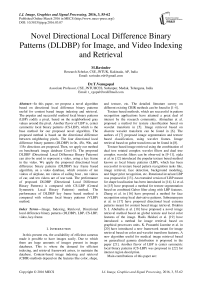Novel Directional Local Difference Binary Patterns (DLDBP) for Image, and Video Indexing and Retrieval
Автор: M.Ravinder, T.Venugopal
Журнал: International Journal of Image, Graphics and Signal Processing(IJIGSP) @ijigsp
Статья в выпуске: 3 vol.8, 2016 года.
Бесплатный доступ
In this paper, we propose a novel algorithm based on directional local difference binary patterns useful for content based image indexing and retrieval. The popular and successful method local binary patterns (LBP) codify a pixel, based on the neighborhood gray values around the pixel. Another flavor of LBP is, center symmetric local binary patterns (CS-LBP), which is the base method for our proposed novel algorithm. The proposed method is based on the directional difference between neighboring pixels. The four directional local difference binary patterns (DLDBP) in 0o, 45o, 90o, and 135o directions are proposed. Then, we apply our method on benchmark image database Corel-1k. The proposed DLDBP (Directional Local Difference Binary Patterns) can also be used to represent a video, using a key frame in the video. We apply the proposed directional local difference binary patterns (DLDBP) key frame based algorithm, on a video database, which consists of ten videos of airplane, ten videos of sailing boat , ten videos of car, and ten videos are of war tank. The performance of proposed DLDBP (Directional Local Difference Binary Patterns) is compared with CS-LBP (Central Symmetric Local Binary Patterns) method. The performance of DLDBP key frame based method is compared with volume local binary patterns (VLBP) method.
Image, Indexing, Retrieval, Directional local difference binary patterns (DLDBP), LBP, CS-LBP, video, key-frame
Короткий адрес: https://sciup.org/15013961
IDR: 15013961
Текст научной статьи Novel Directional Local Difference Binary Patterns (DLDBP) for Image, and Video Indexing and Retrieval
In this present era, the availability of efficient cameras made it possible to have images easily. Due to which there are huge amounts of images present in image databases. This is where the demand for efficient indexing, and retrieval framework arises, to maintain the database. Content-based image indexing and retrieval (CBIR) methods depend on the features like color, shape, and texture, etc. The detailed literature survey on different existing CBIR methods can be found in [1-4].
Texture based methods, which are successful in pattern recognition applications have attained a great deal of interest by the research community. Ahmadian et al. proposed a method for texture classification based on wavelet transform in [5]. Image retrieval based on discrete wavelet transform can be found in [6]. The authors of [7] proposed image segmentation and texture based classification, using wavelet frames. Image retrieval based on gabor transform can be found in [8].
Texture based image retrieval using the combination of dual tree rotated complex wavelet filters and dual tree complex wavelet filters can be observed in [9-11]. ojala et al. in [12] introduced the popular texture based method known as local binary patterns (LBP), which has been successful in texture based pattern recognition tasks like, image retrieval, face detection, background modeling, and finger print recognition, etc. Rotational invariant LBP was proposed in [13]. An extended version of LBP meant for shape localization has been introduced in [14]. Li et al. in [15] have proposed a method for texture segmentation based on combined Gabor filter along with LBP features. Zhang et al. in [16] have proposed a method for face recognition using local derivative patterns. Subramanyam et al. in [17] have proposed directional local extrema patterns meant for content based image retrieval. Ibrahim S. I. Abuhaiba et al. [18] have proposed a novel image retrieval method based on global texture and local color features of the image. Hadis Heidari et al. [19] have introduced a method for image retrieval based on graphical processors units. K. Prasanthi Jasmine et al. in [20] have introduced a new framework meant for image retrieval based on color and wavelet transform features. A new algorithm useful for medical image retrieval based on generalized gamma distribution is proposed in the paper [21]. Another flavor of LBP is center symmetric local binary patterns (CS-LBP) was proposed in [22] for interest region description.
Main contributions of this paper are:
-
1. Directional local difference binary patterns in 0o, 45o, 90o, and 135o directions are proposed. The proposed method is different from CS-LBP.
-
2. Experiments are carried out on benchmark database Corel-1k, and results of our method are compared with CS-LBP method.
-
3. A novel video indexing and retrieval method based on DLDBP is proposed.
The rest of the paper is organized as follows; section 2 talks about related work. Section 3 discusses about the proposed methods. Section 4 projects the experimental work and results, and section 6 concludes the paper with future remarks.
respectively. Subsequent to computing LBP values for all the pixels in the image, extract a histogram, which will act as the feature vector of the image.
An example LBP calculation is as shown in figure, Fig.1.
-
B. Center symmetric local binary patterns (CS-LBP)
Heikkila et al. [18] have proposed center symmetric local binary patterns (CS-LBP) method, in contrast to finding difference between center pixel and each of the neighborhood pixels as in LBP, here, in CS-LBP, the difference between center symmetric pairs of pixels are computed, then, the resultant values will be compared with a predefined threshold value T, as shown in below figure, Fig.2.
-
II. Related Work
There are a number of texture based methods, which have been proposed in the past literature meant for CBIR. Among them, in this section, we are going to discuss about local binary patterns (LBP), center symmetric local binary patterns (CS-LBP), and volume local binary patterns (VLBP).
-
A. Local binary patterns (LBP)
Ojala et al. in [12] have proposed LBP method, which is a successful texture based routine, and it has been practical in some of the popular areas of research such as face identification, image retrieval, and object tracking, etc. LBP value is computed for a 3x3 square of an image by comparing the gray value of the center pixel with its neighborhood pixels as shown in the following equation (1).
|
P 4 (156) |
P 3 (215) |
P 2 (128) |
|
P 5 (128) |
P c (125) |
P 1 (56) |
|
P 6 (96) |
P 7 (211) |
P 8 (112) |
CS -LBP(Pc) = ((P1 -P5) > T) x 20
+ (( P 2 — P 6 ) > T ) x 21
+ (( р з - P 7 ) > T ) x 2 2
LBP ( I ( C )) = £2 ( p -1 ) x f i ( I ( C ) - 1 ( N p )) (1)
p =1
Where
f ( x ) =
x > 0
otherwise
3x3 patch from an image
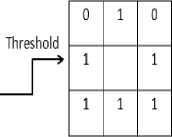
Sum of dot product
IBP Value = 245
+ (( P 4 - P 8 ) > T ) x 2 3
CS - LBP (125) = (0 + 2 + 4 + 8) = 14
Fig.2. An example finding CS-LBP for the center pixel
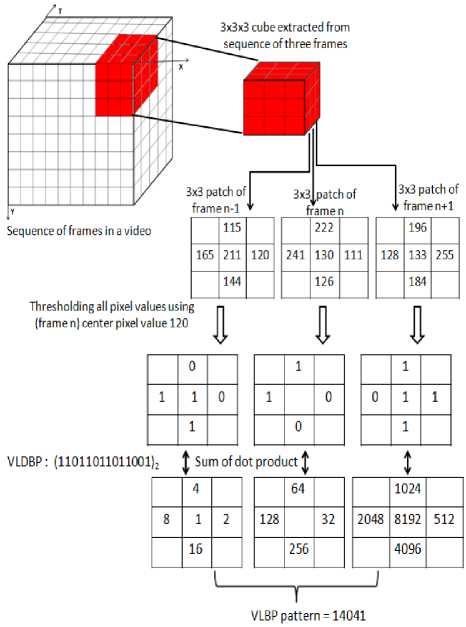
Fig.3. An example implementation of VLBP
Fig.1. An example LBP value calculation
In the above equation I(C), and I(Np) signify gray value of the center pixel, and neighborhood pixel p
As shown in figure Fig.2, the center symmetric local binary pattern for the center pixel is calculated using a predefined threshold value T, in our case T=0, 5, and 10. CS-LBP can be implemented easily, and an image can be represented with less number of texture patterns. CS-LBP is an interested region descriptor which has the strength of scale invariant feature transform (SIFT) combined with local binary patterns (LBP).
-
C. Volume local binary patterns (VLBP)
VLBP method has been proposed in [19], which is useful for dynamic texture extraction from a video. Texture features are extracted by using three sequential frames of the video as shown in below figure, Fig.3.
Detailed implementation of volume local binary patterns (VLBP) method can be found in [19].
-
III. Proposed Frameworks
In this section, we propose two novel frameworks based on DLDBP. Our proposed algorithm of texture extraction from an image has been inspired by the method CS-LBP. In contrast to comparing center semantic pairs of pixels as incase of CS-LBP, our proposed method ompares directional center symmetric pair of pixels. Our method computes directional local difference binary patterns in 0o, 45o, 90o, and 135o directions. For a pixel at position (i , j) in an image I , the DLDBP in all four directions as specified above can be computed with the help of following equations (2), (3), (4), and (5)
respectively.
DLDBP0o (i, j) = ]T 2(p-1) x F1
p = 1
DLDBP45o(i, j) = ]T2(p-1) xF2
p =1
DLDBP90o (i, j) = £ 2(p-1) x F3(4)
p =1
DLDBP135o (i, j) = ]T2(p-1) x F4
p = 1
Where
F1 = f (I(i, j -1) -1(i, j +1))
F2 = f (I(i -1, j -1) -1(i +1, j +1))
F 3 = f (I (i -1, j) -1 (i +1, j ))
F4 = f (I(i -1, j +1) -1(i +1, j -1))
And f ( x) =
x > T (predefined threshold) otherwise
The framework of the proposed DLDBP is as shown in below figure, Fig.4.
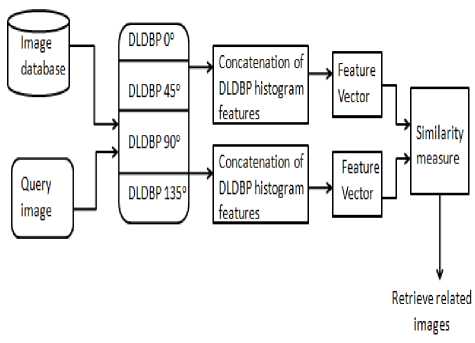
Fig.4. Framework of DLDBP
The initial step in our framework is for a pixel of the input image select the five by five neighborhood pixels around it then find the directional local difference binary patterns in all four directions 0o, 45o, 90o, and 135o using the equations 2, 3, 4, and 5 respectively. After applying the above procedure on all the pixels of the image, feature vector is obtained by concatenating the extracted directional local difference binary patterns. For the query image the feature vector of the query image is compared with pre-computed feature vectors of the images in the database using k-nearest neighbor search algorithm (k value is 10 for precision, and k value is 100 for recall) and relevant images are retrieved as output.
For threshold value T=0, an example of finding DLDBP in 0o direction for 3x3 patch (highlighted in blue color) is as shown in below figure, Fig.5.
|
22 |
15 |
13 |
29 |
61 |
|
87 |
16(b 4 ) |
75(b 3 ) |
18(b 2 ) |
55 |
|
32 |
29(b 5 ) |
26(b 0 ) |
38(b 1 ) |
12 |
|
53 |
18(b 6 ) |
14(b 7 ) |
12(b 2 ) |
109 |
|
156 |
201 |
233 |
92 |
81 |
|
|29- 38|>T |
[26-12)>T |
(75- 55)>T |
||||||||||||||
|
22 |
15 |
13 |
29 |
61 |
22 |
15 |
13 |
29 |
61 |
22 |
15 |
13 |
29 |
51 |
||
|
87 |
16 |
75 |
18 |
55 |
87 |
16 |
75 |
18 |
55 |
87 |
16 |
75 |
18 |
55' |
||
|
32 |
29 |
26 |
38* |
12 |
32 |
29 |
26 |
38 |
12* |
32 |
29 |
26 |
38 |
12 |
||
|
53 |
18 |
14 |
12 |
109 |
53 |
18 |
14 |
12 |
139 |
53 |
18 |
14 |
12 |
109 |
||
|
156 |
231 |
233 |
92 |
81 |
156 |
201 |
233 |
92 |
81 |
156 |
201 |
233 |
92 |
81 |
||
|
H |
b,=l |
b,=l |
||||||||||||||
(16- 18)>Т
|
22 |
15 |
13 |
29 |
61 |
|
87 |
16 |
75 |
18 |
55 |
|
32 |
29 |
26 |
38 |
12 |
|
53 |
18 |
14 |
12 |
109 |
|
156 |
201 |
233 |
92 |
81 |
(18- 75)>Т
|
22 |
15 |
13 |
29 |
61 |
|||
|
87 |
15 |
75' |
18 |
55 |
|||
|
32 |
29 |
26 |
38 |
12 |
|||
|
53 |
18 |
14 |
12 |
109 |
|||
|
156 |
201 |
233 |
92 |
81 |
(32 ■ 26)>Т
|
22 |
15 |
13 |
29 |
61 |
|
87 |
16 |
75 |
18 |
55 |
|
32 |
29 |
2 ST |
38 |
12 |
|
53 |
18 |
14 |
12 |
109 |
|
155 |
201 |
233 |
92 |
81 |
Ь3=1
ь4=о
Н
(32-233)>Т
|
22 |
15 |
13 |
29 |
61 |
||
|
87 |
16 |
75 |
18 |
55 |
||
|
32 |
29 |
26 |
38 |
12 |
||
|
53 |
18 |
14 |
12 |
109 |
||
|
15 |
201 |
233 |
92 |
81 |
(29-92)>Т
|
22 |
15 |
13 |
29 |
61 |
||
|
87 |
16 |
75 |
18 |
55 |
||
|
32 |
29 |
26 |
38 |
12 |
||
|
53 |
18 |
14 |
12 |
109 |
||
|
156 |
20 |
233 |
92 |
81 |
ь7=о
(26-81|>Т
|
22 |
15 |
13 |
29 |
61 |
||
|
87 |
16 |
75 |
18 |
55 |
||
|
32 |
29 |
26 |
38 |
12 |
||
|
53 |
18 |
14 |
12 |
109 |
||
|
156 |
201 |
233 |
92 |
81 |
||
Ь,=0
(53-14)>Т
|
22 |
15 |
13 |
29 |
61 |
||
|
87 |
16 |
75 |
18 |
55 |
||
|
32 |
29 |
26 |
38 |
12 |
||
|
53 |
18 |
14 |
12 |
109 |
||
|
156 |
201 |
233 |
92 |
81 |
||
(18-12)>Т
|
22 |
15 |
13 |
29 |
61 |
||
|
87 |
16 |
75 |
18 |
55 |
||
|
32 |
29 |
26 |
38 |
12 |
||
|
53 |
18 |
14 |
12 |
109 |
||
|
156 |
20 |
233 |
92 |
81 |
Ь,=1
[14-109)>Т
|
22 |
15 |
13 |
29 |
61 |
||
|
87 |
16 |
75 |
18 |
55 |
||
|
32 |
29 |
26 |
38 |
12 |
||
|
53 |
18 |
14 |
12 |
109 |
||
|
156 |
201 |
233 |
92 |
81 |
||
DLDBP 45° pattern = 000100101
DLDBP value = 37
Fig.6. An example calculation of DLDBP in 45 o direction
For threshold value T=0, an example of finding DLDBP in 90o direction for 3x3 patch (highlighted in blue color) is as shown in below figure, Fig.7.
Ьг1
ь,=о
DLDBP 0° pattern = 011101110
DLDBP value = 238
Fig.5. An example calculation of DLDBP in 0 o direction
For threshold value T=0, an example of finding DLDBP in 45o direction for 3x3 patch (highlighted in blue color) is as shown in below figure, Fig.6.
|
22 |
15 |
13 |
29 |
61 |
|
87 |
16(b 4 ) |
75(b 3 ) |
18(b 2 ) |
55 |
|
32 |
29(b 5 ) |
26(b 0 ) |
38(b 1 ) |
12 |
|
53 |
18(b 6 ) |
14(b 7 ) |
12(b 2 ) |
109 |
|
156 |
201 |
233 |
92 |
81 |
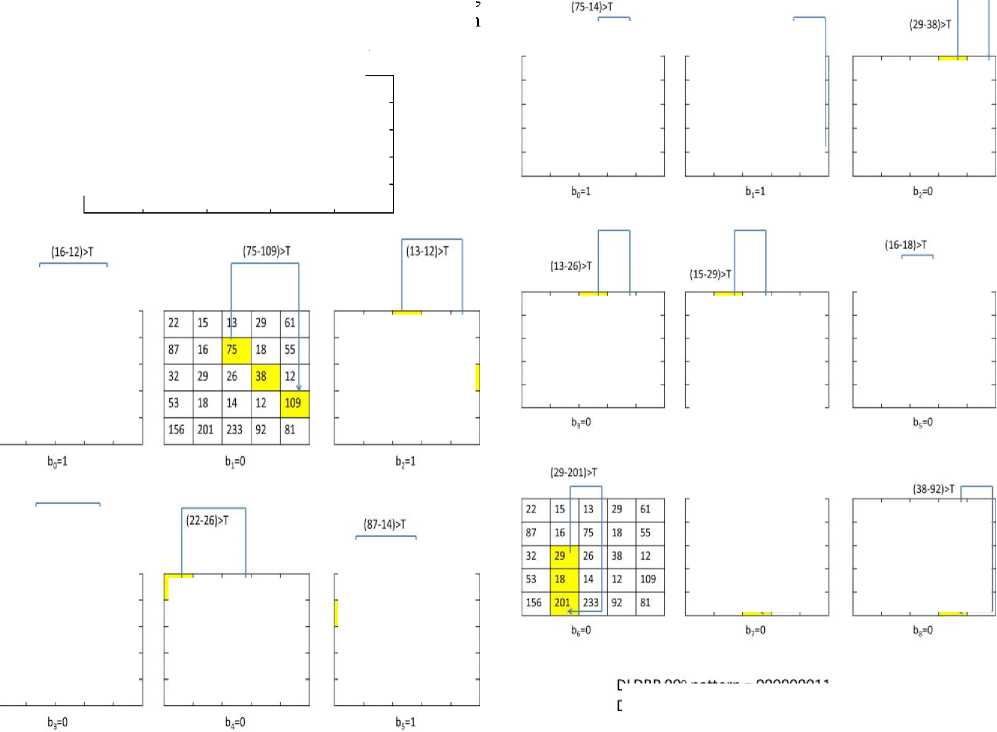
Fig.7. An example calculation of DLDBP in 90 o direction
|
22 |
15 |
13 |
29 |
61 |
|
87 |
16(b 4 ) |
75(b 3 ) |
18(b 2 ) |
55 |
|
32 |
29(b 5 ) |
26(b 0 ) |
38(b 1 ) |
12 |
|
53 |
18(b 6 ) |
14(b 7 ) |
12(b 2 ) |
109 |
|
156 |
201 |
233 |
92 |
81 |
|
22 |
1= |
13 |
29 |
61 |
|
|
87 |
16 |
75 |
18 |
55 |
|
|
32 |
29 |
26 |
38 |
12 |
|
|
53 |
18 |
14 |
12 |
109 |
|
|
156 |
201 |
233 |
92 |
81 |
|
|
(15-38)>T |
||||||
|
22 |
15 |
13 |
29 |
61 |
||
|
87 |
16 |
75 |
18 |
55 |
||
|
32 |
29 |
26 |
38 |
12 |
||
|
53 |
18 |
14 |
12 |
109 |
||
|
156 |
201 |
233 |
92 |
81 |
||
|
22 |
15 |
13 |
29 |
61 |
|
87 |
16 |
75 |
18 |
55 |
|
32 |
29 |
26 |
38 |
12 |
|
53 |
18 |
14 |
12 |
109 |
|
156 |
201 |
233 |
92 |
81 |
|
22 |
15 |
13 |
29 |
6 |
|
|
87 |
16 |
75 |
18 |
5 |
|
|
32 |
29 |
26 |
38 |
12 |
|
|
53 |
18 |
14 |
12 |
109 |
|
|
156 |
201 |
233 |
92 |
81 |
|
|
22 |
15 |
13 |
29 |
61 |
|
|
87 |
16 |
75 |
18 |
55 |
|
|
32 |
29 |
26 |
38 |
12 |
|
|
53 |
18 |
14 |
12 |
109 |
|
|
156 |
201 |
233 |
92 |
81 |
|
|
22 |
15 |
13 |
29 |
51 |
|
|
87 |
16 |
75 |
18 |
55 |
|
|
32 |
29 |
26 |
38 |
12 |
|
|
53 |
18 |
14^ |
12 |
109 |
|
|
156 |
201 |
233 |
92 |
81 |
|
|
22 |
15 |
13 |
29 |
61 |
|
87 |
16 |
75 |
18 |
55 |
|
32 |
29 |
26^ |
38 |
12 |
|
53 |
18 |
14 |
12 |
109 |
|
156 |
201 |
233 |
92 |
81 |
|
|18-12)>T |
||||
|
22 |
15 |
13 |
29 |
61 |
|
87 |
16 |
75 |
18 |
55 |
|
32 |
29 |
26 |
38 |
12 |
|
S3 |
18 |
14 |
12 |
109 |
|
156 |
201 |
233 |
52 |
81 |
|
22 |
15 |
13 |
29 |
61 |
|
87 |
16 |
75 |
18 |
55 |
|
32 |
29^ |
26 |
38 |
12 |
|
53 |
18 |
14 |
12 |
109 |
|
156 |
201 |
233 |
92 |
81 |
|
b4=0 (26-233)>T |
||||
|
22 |
15 |
13 |
29 |
61 |
|
87 |
16 |
75 |
18 |
55 |
|
32 |
29 |
26 |
38 |
12 |
|
S3 |
18 |
14 |
12 |
109 |
|
156 |
201 |
233 |
92 |
81 |
DLDBP 90° pattern = 000000011
DLDBP value = 3
|
22 |
15 |
13 |
29 |
61 |
|
|
87 |
16 |
75 |
18 |
55 |
|
|
32 |
29 |
26 |
38^ |
12 |
|
|
53 |
18 |
14 |
12 |
109 |
|
|
156 |
201 |
233 |
92 |
81 |
|
|
22 |
15 |
13 |
29 |
61 |
|
|
87 |
16 |
75 |
18 |
55 |
|
|
32 |
29 |
26 |
38 |
12 |
|
|
53 |
18 |
14 |
12 |
109 |
|
|
156 |
201 |
233 |
92 |
81 |
|
22 |
15 |
13 |
29 |
61 |
|
|
87 |
16 |
75 |
18 |
55 |
|
|
32 |
29 |
26 |
38 |
12 |
|
|
53 |
18 |
14 |
12 |
109 |
|
|
156 |
201 |
233 |
92 |
81 |
|
For threshold value T=0, an example of finding DLDBP in 135o direction for 3x3 patch (highlighted in blue color) is as shown in below figure, Fig.8.
|
22 |
15 |
13 |
29 |
61 |
|
87 |
16(b 4 ) |
75(b 3 ) |
18(b 2 ) |
55 |
|
32 |
29(b 5 ) |
26(b 0 ) |
38(b 1 ) |
12 |
|
53 |
18(b 6 ) |
14(b 7 ) |
12(b 2 ) |
109 |
|
156 |
201 |
233 |
92 |
81 |
accuracy in retrieval of similar images. That is histogram is calculated for the values from one to two hundred and fifty five (1-255).
An example image from the Corel-1k dataset and the resultant images after applying the proposed directional local difference binary patterns in 0o, 45o, 90o, and 135o method are as shown in below figure, Fig.9.
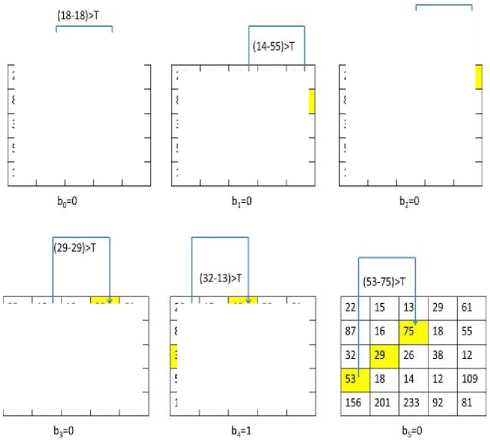
|
22 |
15 |
13 |
29 |
61 |
||
|
87 |
16 |
75 |
18 |
55 |
||
|
32 |
29 |
26 |
38 |
12 |
||
|
53 |
18 |
14 |
12 |
109 |
||
|
156 |
201 |
233 |
92 |
81 |
||
|
22 |
15 |
13 |
29 |
61 |
|
|
87 |
16 |
75 |
18 |
55 |
|
|
32 |
29 |
26 |
38 |
12 |
|
|
53 |
18 |
14 |
12 |
109 |
|
|
156 |
201 |
233 |
92 |
81 |
|
|
(26-61)>T |
||||||
|
22 |
15 |
13 |
29 |
61 |
||
|
87 |
16 |
75 |
18 |
55 |
||
|
32 |
29 |
26 |
38 |
12 |
||
|
S3 |
18 |
14 |
12 |
109 |
||
|
156 |
201 |
233 |
92 |
81 |
||
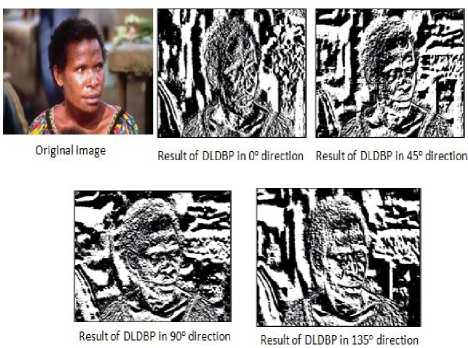
Fig.9. Example DLDBP feature maps
|
22 |
15 |
13 |
29* |
61 |
|
|
87 |
16 |
75 |
18 |
55 |
|
|
32 |
29 |
26 |
38 |
12 |
|
|
53 |
18 |
14 |
12 |
109 |
|
|
156 |
201 |
233 |
92 |
81 |
|
|
22 |
15 |
13 |
29 |
61 |
|
|
87 |
16 |
75 |
18 |
55 |
|
|
32 |
29 |
26 |
38 |
12 |
|
|
53 |
18 |
14 |
12 |
109 |
|
|
156 |
201 |
233 |
92 |
81 |
|
The framework of our proposed DLDBP method is as shown in figure, Fig.4, and the proposed DLDBP algorithm is presented below:
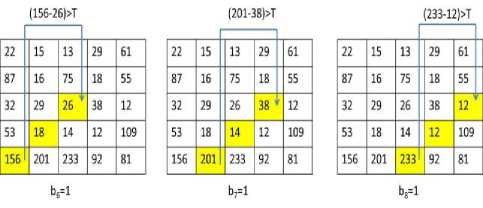
DLDBP 135° pattern = 111010000
DLDBP value = 464
Fig.8. An example calculation of DLDBP in 135 o direction
Step 1: For an input Gray scale image
Step 2: Compute directional local difference binary patterns in 0o, 45o, 90o, and 135o directions for all the pixels in the image.
Step 3: Separate histograms are constructed in 0o, 45o, 90o, and 135o directions using equations (2), (3), (4), and (5) respectively.
Step 4: Feature vector is constructed by concatenating all the histograms obtained in step 3.
Step 5: Query image feature vector is compared with the feature vectors of images in the database using k-nearest neighbor search method.
Step 6: Best matched images are retrieved.
After calculating DLDBP for all the pixels in an image, the image is represented by using histogram calculated with the following equation.
N 1 N 2
H DLDBP ( l ) = ££ h ( DLDBP ( j , k ), l )
j = 1 k = 1
l e [1,2,3,.........,255] (6)
Where
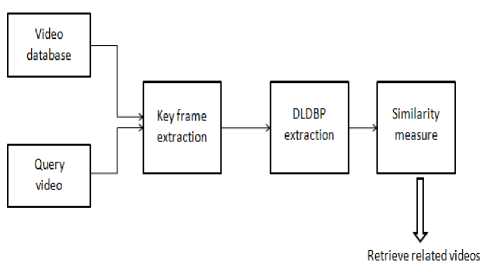
Fig.10. Video indexing and retrieval framework
h ( x , y )
I1
x = y otherwise
As shown in above equation the histogram is calculated for DLDBP, we ignore zero patterns for having
Our video indexing, and retrieval framework is as shown in figure Fig.10. Initial step in the framework is, from the input video extract twenty key frames using histogram based method as presented in below algorithm:
Step 1: For the input video, convert each frame from RGB to equivalent gray scale frame.
Step 2: Compute the histogram of each gray scale frame.
Step 3: Find out the mean histogram of all the histograms computed in step 2.
Step 4: Find out the twenty nearest histograms to mean histogram using k-nearest neighbor search method.
Step 5: Declare the nearest histogram frames as key frames of the video.
As shown in the figure Fig.10, the next step is to find the DLDBP for the selected twenty key frames, and concatenate the DLDBP of all the twenty key frames of the video to form the feature vector of the video.
Our video database consists of ten airplane videos, ten sailing boat videos, ten car videos, and ten war tank videos. For each video in the database, the same procedure of finding key frames and extracting DLDBP is followed. A snap shot of our video dataset is as shown in figure, Fig.11.
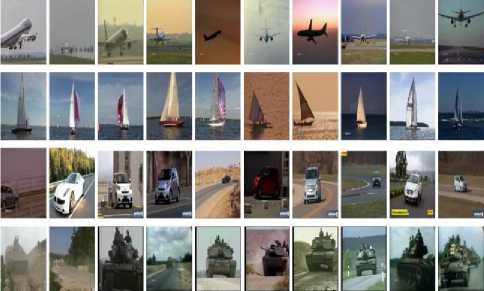
Fig.11. A snapshot of video dataset
-
IV. Experimental Results
We have performed our experiments and tested the proposed method of DLDBP on Corel-1k database. The corel-1k database consists of one thousand images of ten different classes of images; each class type consists of one hundred images. We have evaluated our proposed video indexing and retrieval algorithm on the video database available at [20]. The retrieval performance is evaluated using precision and recall. Precision and Recall are calculated using following equations.
precision
T p
T p + F p
recall =
T p
T p + F n
Where Tp stands for True positive, Fp stands for False positive, and Fn stands for False negative.
Table 1. Precision (n=10) (%) based on top ten images retrieved for the query image with threshold value T = 0, 5, and 10
|
Category |
CS-LBP |
DLDBP |
||||
|
T=0 |
T=5 |
T=10 |
T=0 |
T=5 |
T=10 |
|
|
Africans |
50.7 |
50.7 |
51.7 |
46.7 |
65.1 |
65.5 |
|
Beaches |
46.4 |
46.7 |
46.2 |
54.8 |
50.3 |
45.7 |
|
Buildings |
34.2 |
34.5 |
35.4 |
54.9 |
55.2 |
51.5 |
|
Buses |
56.3 |
78.6 |
81.0 |
91.7 |
91.8 |
88.5 |
|
Dinosaurs |
95.5 |
94.7 |
93.7 |
96.2 |
95.0 |
92.6 |
|
Elephants |
34.6 |
37.5 |
37.8 |
42.9 |
50.8 |
52.1 |
|
Flowers |
76.5 |
85.9 |
90.4 |
77.3 |
83.7 |
85.9 |
|
Horses |
64.5 |
61.8 |
59.8 |
75.4 |
72.1 |
71.6 |
|
Mountains |
26.7 |
32.5 |
32.8 |
35.9 |
43.0 |
41.5 |
|
Food |
25.6 |
32.5 |
39.3 |
49.4 |
58.0 |
61.7 |
|
Average value |
51.10 |
55.54 |
56.81 |
62.52 |
66.50 |
65.66 |
Table 2. Recall (n=100) (%) based on top hundred images retrieved for the query image with threshold value with threshold T = 0, 5, and 10
|
Categor y |
CS-LBP |
DLDBP |
||||
|
T=0 |
T=5 |
T=10 |
T=0 |
T=5 |
T=10 |
|
|
Africans |
32.60 |
30.04 |
26.36 |
29.10 |
37.59 |
33.56 |
|
Beaches |
29.66 |
26.22 |
25.28 |
27.15 |
29.03 |
27.02 |
|
Building s |
19.04 |
17.39 |
18.12 |
25.53 |
24.39 |
24.08 |
|
Buses |
41.09 |
45.23 |
46.77 |
63.95 |
68.35 |
64.71 |
|
Dinosaur s |
88.35 |
76.61 |
69.00 |
79.42 |
75.14 |
66.11 |
|
Elephant s |
18.76 |
19.38 |
20.99 |
22.19 |
24.64 |
27.09 |
|
Flowers |
45.17 |
46.70 |
47.98 |
43.82 |
52.96 |
47.82 |
|
Horses |
33.16 |
34.02 |
32.63 |
33.16 |
41.86 |
38.08 |
|
Mountai ns |
16.32 |
19.77 |
20.32 |
21.28 |
28.29 |
27.08 |
|
Food |
15.74 |
18.82 |
22.71 |
26.71 |
34.48 |
34.74 |
|
Average value |
33.99 |
33.42 |
33.02 |
37.23 |
41.67 |
39.03 |
The results we have obtained after applying the proposed DLDBP method and existing CS-LBP on corel-1k dataset are as shown in above tables Table1 and Table 2. Precision is calculated based on top ten images retrieved for the query image, and recall is computed based on top hundred images retrieved for the query image. On an average our proposed method have achieved precision of 66.5%, and recall of 41.67% with the threshold value T=5.
Comparison of average precision and average recall results of proposed DLDBP and that of existing CS-LBP method are as shown in below graphs in figure, Fig.12.
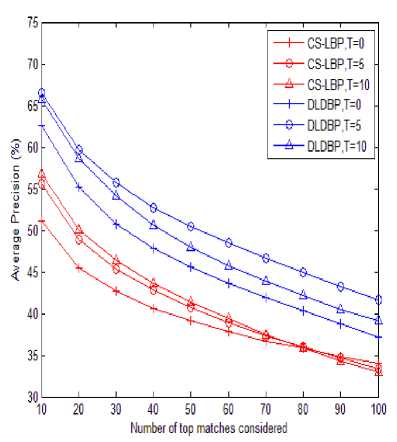
(a)
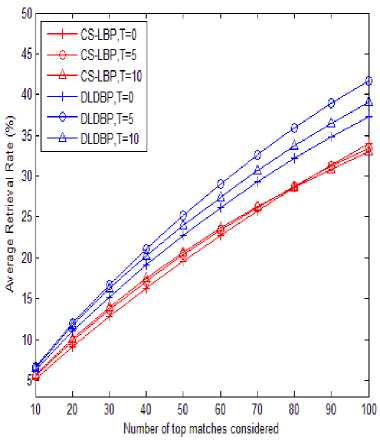
(b)
Fig.12. Comparison of proposed method DLDBP with existing method CS-LBP in terms of (a) average precision (b) average retrieval rate on the benchmark database Corel-1k.
Our proposed video indexing and retrieval frameworks results are as shown below. As discussed above our proposed algorithm is applied on a video database of forty videos (airplane, sailing boat, car, and war tank), which are available at [20].
Table 3. Precision (n=5) (%) based on top five videos retrieved for the query image with threshold value T=5.
|
Category |
VLBP |
Key frame based DLDBP |
|
Airplane |
70 |
84 |
|
Sailing boat |
50 |
68 |
|
Car |
62 |
68 |
|
War tank |
48 |
58 |
|
Average value |
57.5 |
69.5 |
Table 4. Recall (n=10) (%) based on top ten videos retrieved for the query image with threshold value T=5.
|
Category |
VLBP |
Key frame based DLDBP |
|
Airplane |
52 |
58 |
|
Sailing boat |
48 |
52 |
|
Car |
56 |
55 |
|
War tank |
40 |
39 |
|
Average value |
49 |
51 |
The average precision and average retrieval recall results of, video indexing and retrieval framework of key frame based DLDBP, for different numbers of top matches are as shown in the following graphs in figure Fig.13. On an average our proposed algorithm has achieved 69.5% precision and 51% recall.
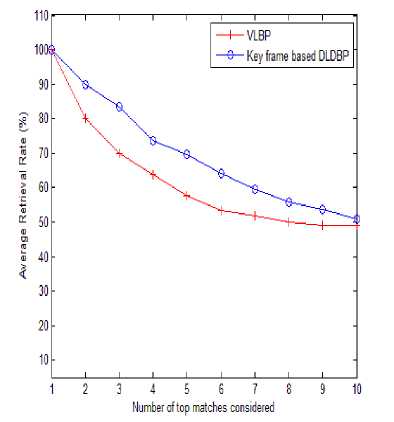
(a)
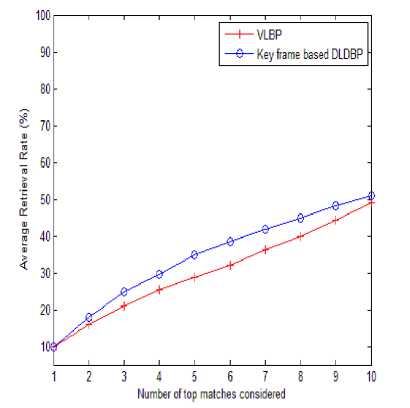
(b)
Fig.13. Comparison of proposed video indexing and retrieval method, key frame based DLDBP with existing method VLBP in terms of (a) average precision (b) average retrieval rate
-
V. Conclusion
In this paper, a novel image indexing and retrieval framework called directional local difference binary patterns (DLDBP) has been proposed, and as well as a framework meant for video indexing and retrieval using key frame based DLDBP has been introduced. Experiments are carried out on benchmark image database Corel-1k and compared the results with existing central symmetric local binary patterns method. Also, we have evaluated the video indexing and retrieval framework on a database available at [20], and compared the results with the existing volume local binary patterns (VLBP) method. Compared to existing methods our proposed methods have shown reasonably good results. As our future work we will try to improve the proposed algorithms performance by introducing Gabor filters.
-
[1] Rui Y, Huang TS “Image retrieval: current techniques, promising directions and open issues”. J Vis Commun Image Represent 10:39–62,1999.
-
[2] Smeulders AWM, Worring M, Santini S, Gupta A, Jain R “Content-based image retrieval at the end of the early years”. IEEE Trans Pattern Anal Mach Intell 22(12):1349–1380, 2000.
-
[3] Kokare M, Chatterji BN, Biswas PK “A survey on current content based image retrieval methods”. IETE J Res 48(3&4):261–271, 2002.
-
[4] Liu Y, Zhang D, Lu G, Ma W-Y “A survey of contentbased image retrieval with high-level semantics”. J Pattern Recognit 40:262–282, 2007.
-
[5] Ahmadian A, Mostafa A “An efficient texture classification algorithm using Gabor wavelet”. In: 25th annual international conference of the IEEE EMBS, pp 930–933, Cancun, Mexico, 2003.
-
[6] Do MN, Vetterli M “Wavelet-based texture retrieval using generalized Gaussian density and Kullback-leibler distance”. IEEE Trans Image Process 11(2):146–158, 2002.
-
[7] UnserM “Texture classification bywavelet packet signatures”. IEEE Trans Pattern Anal Mach Intell 15(11):1186–1191, 1993.
-
[8] Manjunath BS, Ma WY “Texture features for browsing and retrieval of image data”. IEEE Trans Pattern Anal Mach Intell 18(8):837–842, 1996.
-
[9] Kokare M, Biswas PK, Chatterji BN “Texture image retrieval using rotated wavelet filters”. J Pattern Recognit Lett 28:1240–1249, 2007.
-
[10] Kokare M, Biswas PK, Chatterji BN “Texture image retrieval using new rotated complex wavelet filters”. IEEE Trans Syst Man Cybernet 33(6):1168–1178, 2005.
-
[11] Kokare M, Biswas PK, Chatterji BN “Rotation-invariant texture image retrieval using rotated complex wavelet filters”. IEEE Trans Syst Man Cybernet 36(6):1273–1282, 2006.
-
[12] Ojala T, Pietikainen M, Harwood D “A comparative study of texture measures with classification based on feature distributions”. J Pattern Recognit 29(1):51–59, 1996.
-
[13] PietikainenM, Ojala T, Scruggs T, BowyerKW, Jin C, Hoffman K, Marques J, Jacsik M,WorekW “Overview of the face recognition using feature distributions”. J Pattern Recognit 33(1):43–52, 2000.
-
[14] Huang X, Li SZ, Wang Y “Shape localization based on statistical method using extended local binary patterns”. In: Proc Int Conf Image and Graphics, pp 184–187, 2004.
-
[15] Li M, Staunton RC “Optimum Gabor filter design and local binary patterns for texture segmentation”. J Pattern Recognit 29:664–672, 2008.
-
[16] Zhang B, Gao Y, Zhao S, Liu J “Local derivative pattern versus local binary pattern: Face recognition with higher-order local pattern descriptor”. IEEE Trans Image Process 19(2):533–544, 2010.
-
[17] Subrahmanyam Murala, R.P.Maheshwari,
R.Balasubramanian “Directional local extrema patterns: a new descriptor for content based image retrieval” Int J Multimed Info Retr, 2012.
-
[18] Ibrahim S. I. Abuhaiba, Ruba A. A. Salamah, “Efficient Global and Region Content Based Image Retrieval”, I.J. Image, Graphics and Signal Processing, 2012, 5, 38-46.
-
[19] Hadis Heidari, Abdolah Chalechale, Alireza Ahmadi Mohammadabadi, “Parallel Implementation of Texture Based Image Retrieval on The GPU”, I.J. Image, Graphics and Signal Processing, 2013, 9, 36-42.
-
[20] K.Prasanthi Jasmine, P.Rajesh Kumar, “Color and Rotated M-Band Dual Tree Complex Wavelet Transform Features for Image Retrieval”, I.J. Image, Graphics and Signal Processing, 2014, 9, 1-10.
-
[21] T.V.Madhusudhana Rao, Dr.S.Pallam Setty,
Dr.Y.Srinivas, “An Efficient System for Medical Image Retrieval using Generalized Gamma Distribution”,
-
[22] Heikkil M, Pietikainen M, Schmid C “Description of interest regions with local binary patterns”. Pattern Recognit 42:425–436, 2009.
-
[23] Guoying Zhao, Matti Pietikäinen, “Dynamic Texture Recognition Using Volume Local Binary Patterns”.
-
[24] https://sites.google.com/site/benchmarkvideodata/dataset
Список литературы Novel Directional Local Difference Binary Patterns (DLDBP) for Image, and Video Indexing and Retrieval
- Rui Y, Huang TS "Image retrieval: current techniques, promising directions and open issues". J Vis Commun Image Represent 10:39–62,1999.
- Smeulders AWM, Worring M, Santini S, Gupta A, Jain R "Content-based image retrieval at the end of the early years". IEEE Trans Pattern Anal Mach Intell 22(12):1349–1380, 2000.
- Kokare M, Chatterji BN, Biswas PK "A survey on current content based image retrieval methods". IETE J Res 48(3&4):261–271, 2002.
- Liu Y, Zhang D, Lu G, Ma W-Y "A survey of contentbased image retrieval with high-level semantics". J Pattern Recognit 40:262–282, 2007.
- Ahmadian A, Mostafa A "An efficient texture classification algorithm using Gabor wavelet". In: 25th annual international conference of the IEEE EMBS, pp 930–933, Cancun, Mexico, 2003.
- Do MN, Vetterli M "Wavelet-based texture retrieval using generalized Gaussian density and Kullback-leibler distance". IEEE Trans Image Process 11(2):146–158, 2002.
- UnserM "Texture classification bywavelet packet signatures". IEEE Trans Pattern Anal Mach Intell 15(11):1186–1191, 1993.
- Manjunath BS, Ma WY "Texture features for browsing and retrieval of image data". IEEE Trans Pattern Anal Mach Intell 18(8):837–842, 1996.
- Kokare M, Biswas PK, Chatterji BN "Texture image retrieval using rotated wavelet filters". J Pattern Recognit Lett 28:1240–1249, 2007.
- Kokare M, Biswas PK, Chatterji BN "Texture image retrieval using new rotated complex wavelet filters". IEEE Trans Syst Man Cybernet 33(6):1168–1178, 2005.
- Kokare M, Biswas PK, Chatterji BN "Rotation-invariant texture image retrieval using rotated complex wavelet filters". IEEE Trans Syst Man Cybernet 36(6):1273–1282, 2006.
- Ojala T, Pietikainen M, Harwood D "A comparative study of texture measures with classification based on feature distributions". J Pattern Recognit 29(1):51–59, 1996.
- PietikainenM, Ojala T, Scruggs T, BowyerKW, Jin C, Hoffman K, Marques J, Jacsik M,WorekW "Overview of the face recognition using feature distributions". J Pattern Recognit 33(1):43–52, 2000.
- Huang X, Li SZ, Wang Y "Shape localization based on statistical method using extended local binary patterns". In: Proc Int Conf Image and Graphics, pp 184–187, 2004.
- Li M, Staunton RC "Optimum Gabor filter design and local binary patterns for texture segmentation". J Pattern Recognit 29:664–672, 2008.
- Zhang B, Gao Y, Zhao S, Liu J "Local derivative pattern versus local binary pattern: Face recognition with higher-order local pattern descriptor". IEEE Trans Image Process 19(2):533–544, 2010.
- Subrahmanyam Murala, R.P.Maheshwari, R.Balasubramanian "Directional local extrema patterns: a new descriptor for content based image retrieval" Int J Multimed Info Retr, 2012.
- Ibrahim S. I. Abuhaiba, Ruba A. A. Salamah, "Efficient Global and Region Content Based Image Retrieval", I.J. Image, Graphics and Signal Processing, 2012, 5, 38-46.
- Hadis Heidari, Abdolah Chalechale, Alireza Ahmadi Mohammadabadi, "Parallel Implementation of Texture Based Image Retrieval on The GPU", I.J. Image, Graphics and Signal Processing, 2013, 9, 36-42.
- K.Prasanthi Jasmine, P.Rajesh Kumar, "Color and Rotated M-Band Dual Tree Complex Wavelet Transform Features for Image Retrieval", I.J. Image, Graphics and Signal Processing, 2014, 9, 1-10.
- T.V.Madhusudhana Rao, Dr.S.Pallam Setty, Dr.Y.Srinivas, "An Efficient System for Medical Image Retrieval using Generalized Gamma Distribution", I.J.Image, Graphics and Signal Processing, 2015, 6, 52-58.
- Heikkil M, Pietikainen M, Schmid C "Description of interest regions with local binary patterns". Pattern Recognit 42:425–436, 2009.
- Guoying Zhao, Matti Pietikäinen, "Dynamic Texture Recognition Using Volume Local Binary Patterns".
- https://sites.google.com/site/benchmarkvideodata/dataset

